What killed the 32 gauge? Did you know it was ever alive? It was never very common in the United States but it was certainly better known two or three generations ago than it is today. I don't know how many American gun companies made guns in 32 gauge but I know at least Harrington & Richardson made single-shots. I also know at least one American ammunition maker loaded shells in 32 gauge and I imagine more did as well. Today none make either and only Fiocchi imports shells. So, why did the 32 gauge fade away?
Of course we know the answer to that is simple. There were too many other choices and some had to fall by the wayside. The 32 gauge was trying to fill a gap that didn't exist. With a nominal bore diameter of .526" it is only twenty-four thousandths of an inch smaller than a twenty-eight gauge. By comparison the 28 gauge is sixty-five thousandths of an inch smaller than the 20 gauge. Fate could have smiled on the 32 gauge and instead rendered both the 28 gauge and .410 obsolete but it didn't work out that way. Things wouldn't have been better or worse had that happened, only different.
A 28 gauge, 32 gauge, and .410 shell for comparison.
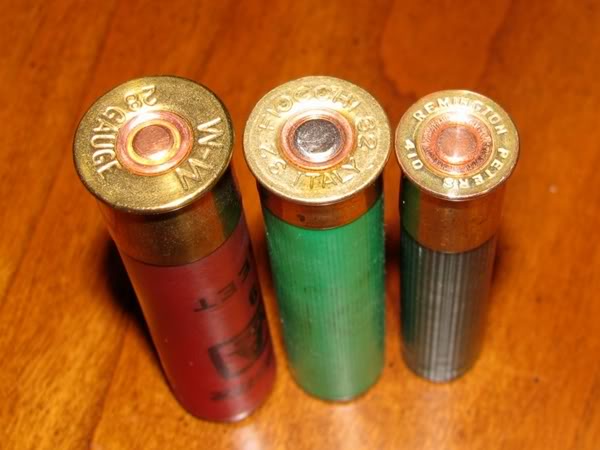
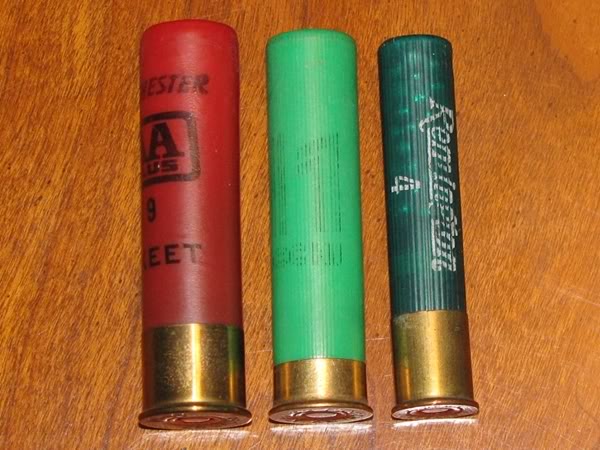
The picture below is from a 1918-1919 Remington catalog. It is interesting to note that both shells have the diameter in millimeters. Unfortunately those designations are way off base. Twelve millimeters for the four-ten? A diameter of .410" is less than eleven millimeters, which is .433". That's as bad as calling it a 36 gauge, which is also still being done today. But what is potentially more dangerous is calling the 32 gauge a 14 millimeter round. Not only is it closer to 13 millimeters than 14 millimeters, but 14 millimeters (or .551") is only one one-thousandth of an inch larger than the nominal 28 gauge bore diameter. My 32 gauge gun was made for the European market and it is stamped "14-65" on the water table of the receiver to represent the bore diameter and chamber length in millimeters. At least they got the 2 1/2" chamber length right.
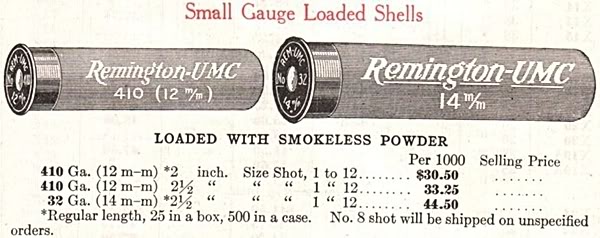
How and why did my interest in the little obscure 32 gauge begin? It was based on nothing more than the desire to be different. It is the same reason why I got my first 28 gauge a couple of decades ago. The 28 was hardly an anomaly then but nobody I knew had one or was hunting with one. That was well before the internet and information was considerably more local then. If someone was old enough to own a shotgun it was either a 12 gauge or a 20. Maybe if they weren't quite old enough to own a shotgun they had a .410. If you want to shoot something out of the ordinary but not totally esoteric today you have a choice between a 24 gauge and a 32 gauge. For that reason I put the word out that I wanted one or the other, or both.
It took about a year until someone contacted me with a 32 gauge for sale. I had run across a few 24 and 32 gauge guns but I thought the prices being asked for them were asinine. I expect to pay a smallbore premium for anything smaller than 20 gauge but the prices I saw on the few guns I found were well out of line with what I would have expected to pay for the same gun in 28 gauge or .410. After a few conversations with the gentleman that contacted me I owned a 32 gauge double gun. There wasn't much haggling. Negotiations over price are commonplace with guns that are a dime a dozen or when the asking price is well out of line but the seller and I were within $100 of where we thought the price should be. We happily met in the middle.
Because I wasn't aggressively searching for the gun I wasn't prepared to load shells for it. I could have bought factory loaded Fiocchi shells at around $15 per box through the mail but I'm not spending that much to feed any gun, especially when I have considerably nicer guns sitting in the safe that I can buy shells for at any sporting goods store or Wal-Mart. I don't buy factory ammunition for any other guns I shoot and I didn't plan on doing it with the 32 gauge either. It was time to start looking for reloading equipment, supplies, and load data.
The search for a press didn't last long nor did it go very well. There aren't any being made. That's simple enough and no further effort will have to be spent searching for one. I need to mention that while discussing the situation with someone at MEC it was mentioned that making them has been considered. Perhaps the most helpful source I talked to was Tom Armbrust at Ballistics Research. He told me what modifications they did to convert 10 gauge MEC presses to load 8 gauge shells. I could accomplish the same feat by modifying an existing press. I already had a MEC 600 Jr. four-ten press so all I needed was a couple of parts and some minor machine work. Here are the details in case someone else is interested in doing the same thing.
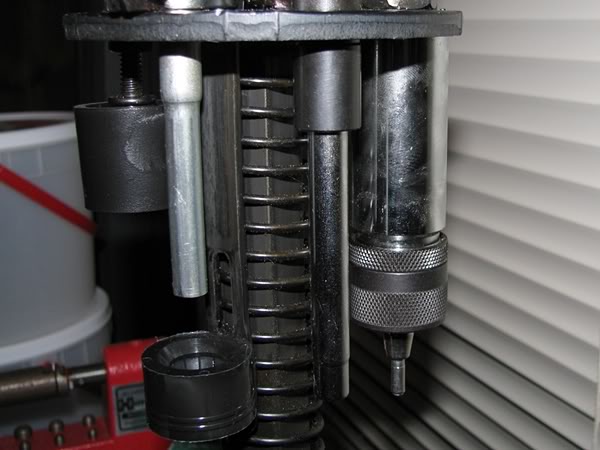
At station number one a deprime punch for a .410 press is required. Also, a resize ring for a .410 press has to be drilled out to resize the hulls. I asked the person doing the work for me to make mine .006" larger than a new hull.
At station number two a reprime punch for a .410 press is required. Since I started with a .410 press I had nothing to change at this station. I will say that because the inside of the hull is considerably larger than the punch it doesn't do a good job of aligning the primer pocket up with the new primer. I found the best way to deal with this is to insert the new primer into the primer pocket as I move the hull from station one to station two. You could also have a reprime punch made that is slightly smaller than the inside diameter of the hull if you are skilled enough to do it yourself or if you can justify the cost of having someone else do it. It wasn't that important to me.
At station three you will need a wad guide fingers for a 28 gauge press. You can choose a rammer tube and drop tube for either a 28 gauge or .410 press. If you have to buy one I recommend the larger of the two. It will do a better job of keeping the wad centered as you seat it and is less prone to having larger shot sizes sticking in the tube. Since I already had the parts for a .410 press that is what I used.
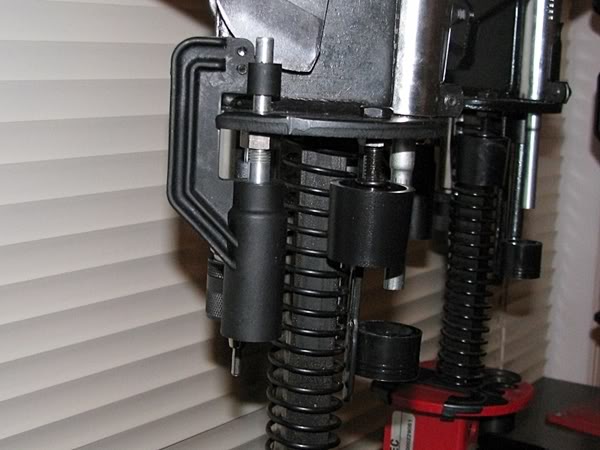
If you plan to roll crimp you don't need to worry about stations four and five. Because doing everything on one machine is faster and hull life is longer with folded crimps that is the route I took. If you want to do the same thing you will need to get a spindex crimp starter for a 28 gauge press.
At the last station you will need a cam crimp assembly for a .410 press and a cam crimp punch for a 28 gauge press. The inside of the cam crimp assembly will have to be enlarged and the cam crimp punch will have to be turned down. These are not difficult to do but since I have no skills as a machinist I left the task to my gunsmith. Go slow when reaming out the cam crimp assembly. It is made from nylon and if you try and remove the material too fast you can break it. I also want to mention that you can get fully functional, yet slightly flared shells using an unaltered 28 gauge cam crimp assembly and cam crimp punch. I used my 28 gauge press to crimp a couple and they dropped right into the chambers of my gun.
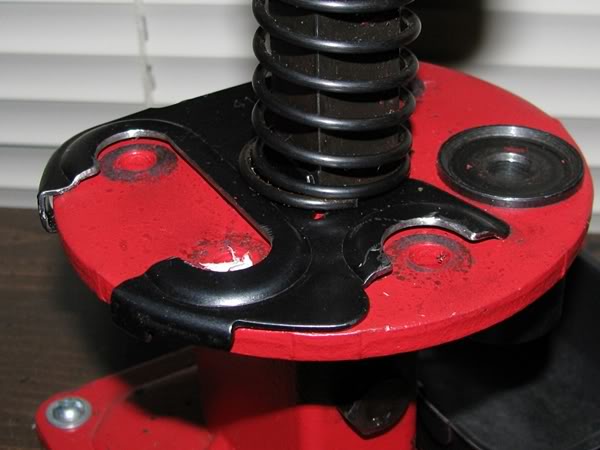
Lastly you will need a shellholder for a .410 press. Enlarge the holes on it so a hull that has been fired can easily slide into them. Make sure when doing this you maintain the same center or radius point of each opening.
But what about the capabilities of the 32 gauge? It is difficult to find guns, and they are generally more expensive when you do find one. Factory ammunition is also more expensive and you have to jump through hoops to reload. I currently have no more than a handful of published reloading recipes and based on telephone conversations I've had with people and companies that do such things it doesn't appear that any more will be coming along in the near future. So how can anyone possibly justify the need for the 32 gauge. I'd be lying if I said that I can. However, justification has never been a good enough reason to stop many people from doing many things, especially when we are talking about guns. I will tell you that if the criteria is based solely on ability the 32 gauge is worthy of the task when it comes to effectively and efficiently killing snipe. I've had good luck shooting them with the .410 and the 32 gauge is undoubtedly superior to it in the field. The more efficient shot column combined with far better wad designs that cushion the shot are the reasons why and when using the 32 gauge its superiority is visibly obvious. Now you just have to decide whether you want to shoot a gun that stands out from the crowd or one that is part of the status quo.


